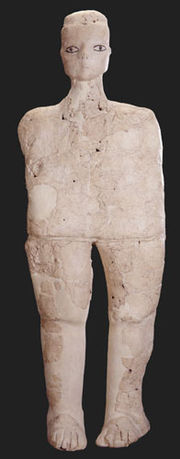
'Ain Ghazal
Encyclopedia

Neolithic
The Neolithic Age, Era, or Period, or New Stone Age, was a period in the development of human technology, beginning about 9500 BC in some parts of the Middle East, and later in other parts of the world. It is traditionally considered as the last part of the Stone Age...
site located in North-Western Jordan
Jordan
Jordan , officially the Hashemite Kingdom of Jordan , Al-Mamlaka al-Urduniyya al-Hashemiyya) is a kingdom on the East Bank of the River Jordan. The country borders Saudi Arabia to the east and south-east, Iraq to the north-east, Syria to the north and the West Bank and Israel to the west, sharing...
, on the outskirts of Amman
Amman
Amman is the capital of Jordan. It is the country's political, cultural and commercial centre and one of the oldest continuously inhabited cities in the world. The Greater Amman area has a population of 2,842,629 as of 2010. The population of Amman is expected to jump from 2.8 million to almost...
. It dates as far back as 7250 BC, and was inhabited until 5000 BC. At 15 hectares (37 ac), 'Ain Ghazal ranks as one of the largest known prehistoric settlements in the Near East.
Settlement
In its prime era circa 7000 BCE, it extended over 10-15 hectares (25–37 ac) and was inhabited by ca. 3000 people (four to five times contemporary Jericho). After 6500 BC, however, the population dropped sharply to about one sixth within only a few generations, probably due to environmental degradation (Köhler-Rollefson 1992).'Ain Ghazal started as a typical aceramic Neolithic
Neolithic
The Neolithic Age, Era, or Period, or New Stone Age, was a period in the development of human technology, beginning about 9500 BC in some parts of the Middle East, and later in other parts of the world. It is traditionally considered as the last part of the Stone Age...
village of modest size. It was set on terraced ground at a valley-side, and was built with rectangular mud-brick houses that accommodated a square main room and a smaller anteroom. Walls were plastered with mud on the outside, and with lime plaster inside that was renewed every few years.
Being an early farming community, the 'Ain Ghazal people cultivated cereals (barley and ancient species of wheat), legumens (peas, beans and lentils) and chickpeas in fields above the village, and herded domesticated goats. However, they also still hunted wild animals - deer, gazelle, equid
Equidae
Equidae is the taxonomic family of horses and related animals, including the extant horses, donkeys, and zebras, and many other species known only from fossils. All extant species are in the genus Equus...
s, pigs and smaller mammals such as fox or hare.
Culture
'Ain Ghazal people buried some of their dead beneath the floors of their houses, others outside in the surrounding terrain. Of those buried inside, often later the head was retrieved and the skull buried in a separate shallow pit beneath the house floor. Also, many human remains have been found in what appears to be garbage pits, where domestic waste was disposed, indicating that not every deceased was ceremoniously put to rest. Why only a small, selected portion was properly buried and the majority just disposed of, remains unresolved.'Ain Ghazal is renowned for a set of anthropomorphic statues found buried in pits in the vicinity of some special buildings that may have had ritual functions. These statues are half-size human figures modeled in white plaster around a core of bundled twigs. The figures have painted clothes, hair, and in some cases, ornamental tattoos or body paint. The eyes are created using cowrie shells
Cowry
Cowry, also sometimes spelled cowrie, plural cowries, is the common name for a group of small to large sea snails, marine gastropod molluscs in the family Cypraeidae, the cowries...
with a bitumen pupil.
In all, 32 of those plaster figures were found in two caches, 15 of them full figures, 15 busts, and 2 fragmentary heads. Three of the busts were two-headed, the significance of the two headed statues is not clear.
Archaeology
'Ain Ghazal was discovered in the 1974 by developers who were building a road through the area. Excavation began in 1982, however by this time, around 600 meters (1,970 ft) of road ran through the site. Despite the damage urban expansion brought, what remained of 'Ain Ghazal provided a wealth of information and continued to do so until 1989. One of the more notable archaeological finds during these first excavations came to light in 1983. While examining a cross section of earth in a path carved out by a bulldozer, archaeologists came across the edge of a large pit 2.5 meters (8 ft) under the surface containing plaster statues. Another set of excavations, under the direction of Gary O. RollefsonGary O. Rollefson
Gary O. Rollefson is an American Anthropologist. He has specialized on Near Eastern prehistoric archeology and prehistoric religion.-Biography:...
and Zeidan Kafafi took place in the early 1990s. The site was included in the 2004 World Monuments Watch by the World Monuments Fund
World Monuments Fund
World Monuments Fund is a private, international, non-profit organization dedicated to the preservation of historic architecture and cultural heritage sites around the world through fieldwork, advocacy, grantmaking, education, and training....
, to call attention to the threat of encroaching urban development.
External links
- 'Ain Ghazal statues at Smithsonian InstitutionSmithsonian InstitutionThe Smithsonian Institution is an educational and research institute and associated museum complex, administered and funded by the government of the United States and by funds from its endowment, contributions, and profits from its retail operations, concessions, licensing activities, and magazines...
- 'Ain Ghazal Excavation Reports (menic.utexas.edu)
- Institut du Monde Arabe
- The ‘Ain Ghazal Statue Project
- The Joukowsky Institute of Archaeology

